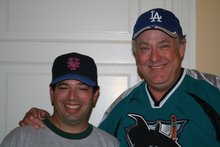
As of this morning the LA Dodgers are just 2.5 games behind the first-place Arizona Diamondbacks in the underachieving National League West. It is amazing when you think about all the troubles the team has gone through this season. With injuries to brittle old veterans and mistakes made by unseasoned youngsters, the Bums have had multiple problems with pitching and scoring runs.
But, don’t count out the Dodgers just yet. Last night they didn’t get a single hit and still beat the Angels, 1-0. It is only the fifth time in modern baseball history that something like this has happened.
Believe it or not, this team could be coming together at just the right time. Up-and-coming stars like James Loney, Matt Kemp, Russell Martin, Chad Billingsley and Andre Ethier have displayed moments of brilliance. Injured former stars like Nomar Garciaparra, Rafael Furcal, Brad Penny and Andruw Jones will be returning to the team soon. If they are healthy and can contribute at all, it could get interesting.
Maybe I’m dreaming, but who knows? Stranger things have happened, last night’s game being a prime example.
This account of the game appeared on www.cbssportsline.com:
Jered Weaver and Jose Arredondo combined to no-hit the Los Angeles Dodgers on Saturday night -- and it still wasn't good enough for the Los Angeles Angels.
The Dodgers became the fifth team in modern major league history to win a game in which they didn't get a hit, defeating the Angels 1-0. Weaver's error on a slow roller led to an unearned run by the Dodgers in the fifth.
Weaver downplayed the fact the Angels lost without giving up a hit.
"Any loss, no matter what, is tough," he said. "I'm sure you guys are going to eat this up a lot more than I am. I don't call it a no-hitter for me. I only went six innings."
The Dodgers' Joe Torre thought it might've been his weirdest win as a manager.
"I'd really have to reach down, and I don't really remember too much, but that's about as bizarre as you can get," he said.
With the Angels trailing in the interleague game at Dodger Stadium, Weaver was pulled for a pinch-hitter in the seventh inning after throwing 97 pitches. Arredondo pitched the next two innings.
Because the Dodgers didn't have to bat in the ninth, the game doesn't qualify as a no-hitter. It was only the fifth such game since 1900, and first since Boston's Matt Young in 1992, according to the Elias Sports Bureau.
The Angels' Torii Hunter said he has never been involved in such a strange game.
"Never," he said, "not even in Little League."
The Dodgers' Chad Billingsley (7-7) scattered three hits over seven innings, then Jonathan Broxton and Takashi Saito shut out the Angels for the next two innings.
Weaver (7-8) was victimized by his own fielding error with one out in the fifth inning that allowed Matt Kemp to reach first.
Kemp's spinning squibber rolled to the right of the mound and Weaver rushed toward first base to grab the ball, but bobbled it. The ruling on whether it was a hit or an error was a close one, since Weaver would have had to field the ball cleanly -- and first baseman Casey Kotchman was off the bag. Official scorer Don Hartack ruled it an error.
"I believe if he just picked it up with his bare hand and flipped it, he gets him by a good step and a half," Hartack said. "So my thinking was, it really wasn't a bang-bang play. I looked at the replay once and it looked like Kemp was a good seven steps away, so my thinking was Weaver had plenty of time to make the out."
Kemp completely agreed with the scoring.
"I hit it off the end of the bat and it had a little funky English on it," he said. "He could have made the play, but he just dropped the ball. It was an error. I mean, if they'd have given me a hit, I'd have been happy. But it was an error by far."
Kemp stole second and continued to third on catcher Jeff Mathis' throwing error, then scored on Blake DeWitt's sacrifice fly.
Weaver struck out six, walked three and hit a batter in his six innings. Chone Figgins pinch-hit for him in the seventh with two outs and a runner on second, but grounded out.
Baseball's other no-hit losers were Andy Hawkins of the Yankees in 1990, Steve Barber and Stu Miller of Baltimore in 1967, and Ken Johnson of Houston in 1964.
Billingsley struck out seven and walked three.
The Angels, shut out for the second consecutive night, had six hits but didn't get a runner as far as third base. They had runners on first and second against Saito with two out in the ninth, but he struck out pinch-hitter Reggie Willits to earn his 12th save.


